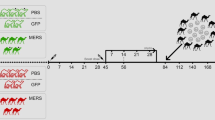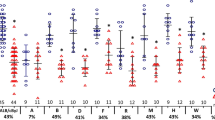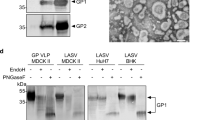Abstract
MACHUPO virus, the aetiological agent of Bolivian haemorrhagic fever, is an ether-sensitive RNA virus immunologically classified as a member of the Tacaribe group of “arboviruses”1–3. Repeated isolation of this virus from the cricetine rodent Calomys callosus4, the demonstration of chronic virus infection with persistent viruria in this animal5, and the inability to recover virus from a large number of arthropods associated with C. callosus6, led to serious doubt that biological transmission by arthropods was an important mechanism in the natural maintenance of Machupo virus. To facilitate inquiry into this problem, a laboratory colony of C. callosus was established7. We report here preliminary work on the dynamics of experimental infection which demonstrates that Machupo virus regularly induces immune tolerance in Calomys infants and in a portion of animals infected as adults.
This is a preview of subscription content, access via your institution
Access options
Subscribe to this journal
Receive 51 print issues and online access
$199.00 per year
only $3.90 per issue
Buy this article
- Purchase on Springer Link
- Instant access to full article PDF
Prices may be subject to local taxes which are calculated during checkout
Similar content being viewed by others
References
Johnson, K. M., Wiebenga, N. H., Mackenzie, R. B., Kuns, M. L., Webb, P. A., Justines, G., and Beye, H. K., Proc. Soc. Exp. Biol. and Med., 118, 113 (1965).
Wiebenga, N. H., Amer. J. Trop. Med. Hyg., 14, 802 (1965).
Pinheiro, F. P., Shope, R. E., De Andrade, A. H. P., Bensabath, G., Cacios, G. V., and Casals, J., Proc. Soc. Exp. Biol. and Med., 122, 531 (1966).
Johnson, K. M., Kuns, M. L., Mackenzie, R. B., Webb, P. A., and Yunker, C. E., Amer. J. Trop. Med. Hyg., 15, 103 (1966).
Johnson, K. M., Mackenzie, R. B., Webb, P. A., and Kuns, M. L., Science, 150, 1618 (1965).
Kuns, M. L., Amer. J. Trop. Med. Hyg., 14, 813 (1965).
Justines, G., and Johnson, K. M., Lab. Anim. Care (in the press).
Justines, G., and Johnson, K. M., Amer. J. Trop. Med. Hyg., 17, 788 (1968).
Webb, P. A., Johnson, K. M., and Mackenzie, R. B., Proc. Soc. Biol. and Med. (in the press).
Earley, E., Peralta, P. H., and Johnson, K. M., Proc. Soc. Exp. Biol. and Med., 125, 741 (1967).
Volkert, M., and Hannover Larsen, J., in Progress in Medical Virology (edit. by Melnick, J. L.), 7, 160 (Hafner, New York, 1965).
Vogt, P. K., in Perspectives in Virology (edit. by Pollard, M.), 5, 199 (Academic Press, New York, 1967).
Dalton, A. J., Rowe, W. P., Smith, R. E., Wilsnack, R. E., and Pugh, W. E., J. Virol., 2, 1465 (1968).
Acheson, N. H., and Tamm, I., Virology, 32, 128 (1967).
Murphy, F. A., Harrison, A. K., and Tzianabos, T., J. Virol., 2, 1315 (1968).
Schmuniz, G., Weissenbacher, M., and Parodi, A. S., Arch. Ges. Virus Forsch., 21, 200 (1967).
Author information
Authors and Affiliations
Rights and permissions
About this article
Cite this article
JUSTINES, G., JOHNSON, K. Immune Tolerance in Calomys callosus infected with Machupo Virus. Nature 222, 1090–1091 (1969). https://doi.org/10.1038/2221090a0
Received:
Revised:
Issue Date:
DOI: https://doi.org/10.1038/2221090a0
Comments
By submitting a comment you agree to abide by our Terms and Community Guidelines. If you find something abusive or that does not comply with our terms or guidelines please flag it as inappropriate.



